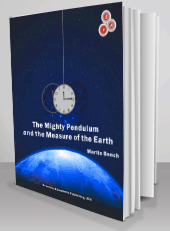Scientific & Academic Publishing
SAP is an open access publisher of journals covering a wide range of academic disciplines.
SAP is an open access publisher of journals covering a wide range of academic disciplines.

Description
The world is in perpetual turmoil and motion – it is a vibrant extravaganza of interactions, oscillations and pulses. Movement surrounds us, and our lives dance to its ever-changing tune. Deep down, however, there is an underlying order, at least of sorts, and we can breakdown the complex motions of the everyday world into the summation of simple harmonic waves. Underpinning all this dynamical mêlée is the pendulum – perhaps the simplest experimental device ever invented: a weight and a piece of string. The pendulum for all its simplicity, however, has been at the historical center of humanities exploration of the Earth and the heavens, and this book is about some of that remarkable history. Based upon material used in a history of astronomy course, and written with the science undergraduate student in mind, the text takes the reader through a mathematical, physical and historical tour of the pendulums many contributions to fundamental science. From the study of Earth’s interior, to the measure of time and space; from the Victorian parlor room, to the boundaries of chaos; to the overarching domains of cosmology and the quantum world, the pendulum, indeed, the mighty pendulum has featured front and center. The pendulum, subtle in its power and long in its reach, has faithfully accompanied humanity on its quest to understand the universe. And, while the narrative of the pendulum begins in our ancient past, its story continues to have great contemporary relevance, and there is every reason to suppose that both its metaphorical and experimental importance will continue into the distant future.
Table of Contents
Chapter 1:The mathematical pendulum
Dimensional analysis
A first approximate equation
The Seconds Pendulum
Gravimetry and Kater’s pendulum
Measuring height by time
The Devil is in the details
More details and complications
Conservation of momentum and Newton’s cradle
Conservation of energy and the ballistic pendulum
The tautochrone
Both isochronal and fastest
A pendulum that can never be: I
Circular orbits
The Newtonian domain
Our strange 3-D world
The conical pendulum
The governor
The paraconical pendulum
The eclipse effect: fact or fiction?
Galileo - again
Chapter 2: Making time
Absolute time and relativity
A pendulum that can never be: II
The movement of time
Ancient time
Celestial time
Mechanical time
The chaos of Pluto
The heartbeat of time
The clock of Boys
The pendulum transformed
International Atomic Time and the leap second
Time bounds the Earth
Hooke’s animadversions
The pendulum is dead. Long live the pendulum
Chapter 3: The Shape of the Earth
Little Pendulum Island
A classic result
Shadow lands
There and back again
A map without wrinkles
Richter’s adventures
Newton’s equatorial bulge
Discontent goes to Peru
Maupertius goes to Lapland
Running hot and cold
Give a little, take a little
The Great Arc
The Challenger Deep
The Figure of the Earth
Earthquakes and Polar Drift
Sympathetic vibrations
Chapter 4: Weighing the Earth
In the balance
Weighing gravity
Packing it in
Defining up
The attraction of mountains
Maskelyne heads north
Airy down a coalmine
The Cavendish experiment
The measure of big-G
A pendulum that can never be: III
The roots of mountains
Gravitational aether
The weak equivalence principle
How constant is big-G
An aside on the TOE
The nanomechanical whisker
Chapter 5: Moving Heaven and Earth
Hipparchus finds precession
The ever-inventive Robert Hooke
Newton’s alternative way
Bradley’s aberration
Ole Rømer sees the light
Bradley gets the nod
Halley finds a proper motion
Trigonometric parallax measured
Parallax found
Passing ships
Chapter 6: All in a spin
What goes up …..
A technical aside on spin dynamics
A letter from Newton
At Garraways
Flamsteed checks for consistency
The pendulum at the Parthenon
A technical aside: the sin(φ) term
A centrifugal correction and spin-apart
The Eötvös effect: a final correction
The gyroscope and the spin that isn’t
The Croll-Melankovich cycle
Inconstant spin, and spin down
Moon drift and the end of all things
The inverted pendulum
Chapter 7: From beauty, to resonance, to chaos
The harmonograph
Lissajous figures
Dean’s two-point pendulum
Huygens’s odd sympathy and the spark-gap oscillator
Barton’s pendulum, Kirkwood gaps and the Lorentz atom
The pendulum goes discrete
The quantum oscillator – one step too far
Duffing’s non-linear oscillator
Constancy meets chaos
The Lorenz attractor
The double compound pendulum
Afterwords
Further notes and references
Index